Fresh Vegan Kitchen
David Bailey, Pavilion Books Company LtdISBN 978-1-911642-07-3, Pages 175, Size 220mm x 223mm
Raw recipes 43, Cooked recipes 76
"Fresh Vegan Kitchen — Delicious Recipes for the Vegan and Raw Kitchen" offers a large selection of Asian-inspired vegan and raw vegan recipes.
Pavilion Books Company Ltd, David Bailey
Raw recipes 43 (4), Cooked recipes 76 (4)
Additional photos (10)
Overview
The Fresh Vegan Kitchen by David and Charlotte Bailey is a cookbook that can provide even the most experienced vegan chef with new ideas — this is thanks to the large variety of creative, Asian-inspired recipes it contains. However, many of the recipes are actually not that healthy as they often call for large amounts of oil and fat and sometimes include a less than desirable choice of ingredients. In this aspect, the cookbook unfortunately does not differ from the majority of other vegan cookbooks on the market. But by slightly modifying the recipes, you can conjure up dishes that are not only tasty, but also healthy.
| Critical book reviews |
Overall impression
The Fresh Vegan Kitchen — Delicious Recipes for the Vegan and Raw Kitchen by David and Charlotte Bailey includes a diverse selection of vegan and raw vegan dishes. David and Charlotte Bailey define raw food as food that has been heated at a maximum temperature of 46 °C. They point out that some of the recipes listed as raw in their cookbook do contain smaller amounts of non-raw ingredients. Their goal is to make the most of the wide variety of vegan ingredients available, rather than simply leaving out ingredients. This is why their recipes are mainly influenced by dishes from Asian countries, which have a long tradition of vegetarian cuisine.
The many varied and imaginative dishes are a good example of just how diverse vegan cuisine is. Unfortunately, only some of the recipes include photos. The recipes are identified as raw, gluten-free, and/or wheat-free. For planning purposes, it would be he helpful to have additional information about preparation times. Most of the dishes contain common ingredients and require only very few little equipment.
David and Charlotte Bailey believe that there are many reasons to eat a vegan diet: not only animal welfare and the environment but also health is an important aspect. They have therefore tried to keep the amount of saturated fats and refined products in the recipes low, as well as the amount of salt and sugar. Unfortunately, this has only been achieved to a limited extent; as a result of the oil or coconut milk used, many of the dishes contain a large amount of fat in places where it would have been easy to reduce. The frequent use of olive oil and cashews is undesirable because of their poor ratio of omega-6 (LA) to omega-3 fatty acids (ALA). In many cases, it would have been easy to reduce the amount of fat called for or use other ingredients such as canola oil or walnuts.
It is nice to see that the basic recipes for homemade broths and spice pastes are used in many of the recipes. However, in other places processed ingredients such as canned foods and even ketchup are called for instead of more healthy natural products. It would be nice if there were a more consistent adherence to healthy eating principles.
The Fresh Vegan Kitchen by David und Charlotte Bailey is a comprehensive cookbook that shows the wide variety of vegan options that exist. And just small changes in favor of more healthy ingredients make it clear that vegan cuisine is not only varied and delicious but that it can also be healthy. The Fresh Vegan Kitchen is currently only available in English and can be purchased from Pavilion Books and Amazon.
About the authors
David Bailey, who has several years of experience working in top restaurants, and his wife Charlotte started their business Wholefood Heaven in 2010. They sell vegetarian street food at markets, festivals, and other events. Their famous Buddha Bowl won the 2011 British Street Food Awards for Best Main Dish. In addition to their business, they are continually developing new recipes and writing cookbooks.
Contents
The Fresh Vegan Kitchen begins with a general introduction that is followed by a section on the health benefits of raw food and one that provides vegan cooking tips.
The recipes are divided into ten chapters:
- Breakfasts
- Soups
- Small plates & street food
- Salads
- Currys & mains
- Sides & dips
- Desserts
- Pickles, spreads & treats
- Drinks & smoothies
- Basics
Breakfasts:
This chapter offers a small selection of breakfast dishes, most of which are on the sweet side. You will find, for example, recipes that call for lots of seeds, nuts, and dried fruits like G’raw’nola and a fruity Acai Bowl.
Soups:
In this chapter, you will find a wide variety of soups, some of which are raw vegan soups. The Asian-inspired Laksa and the Chilled Cucumber and Wasabi Soup are just two examples of the recipes here.
Small plates & street food:
The recipes included in this section can be served as appetizers, snacks, or main courses. About one-third of the dishes contain tofu products and about a half contain convenience products such as tortillas or dumpling dough. Examples of recipes here are the Bao Zi Steamed Buns and Vegetable Tempura with a Citrus Soy Dipping Sauce.
Salads:
In this section, you can look forward to a wide variety of delicious salads, of which about two-thirds are raw. Just to name a few, Som Tam Salad, Aromatic Thai Salad, Hot Aubergine Salad, and Raw Sprouted Salad are some of the options to choose from.
Currys & mains:
Many of the numerous main courses included are vegan versions of well-known international dishes, and apart from a few exceptions the main dishes are not raw. Examples of recipes found here are Beer-Battered Tofu “Fish” and Chips with Tartare Sauce and Mushy Peas and Sicilian Arancini (fried risotto balls). Given the high oil content, many of this recipes in this section contain quite a few calories.
Sides & dips:
Along with dips like Baba Ganoush, this short chapter offers vegetable and tofu sides such as Maple-Glazed Tofu.
Desserts:
This chapter is full of fruity, chocolaty, and creamy desserts. Recipes to try out include Poached Pears with Vanilla Cashew Cream and Peanut and Black Sesame Sweet Dumplings.
Pickles, spreads & treats:
In this section, you will find a wide variety of different types of recipes: from Sauerkraut and Powerballs to Probiotic Raw Nut Cheese.
Drinks & smoothies:
Examples of recipes in this section are Soya Milk and Homemade Lemonade with Chia Seeds.
Basics:
You will find recipes for dressings, sauces, broths, and spice pastes here that are then called for in many of the recipes. Asian Vegetable Stock and Laksa Curry Paste are just two examples.
The Fresh Vegan Kitchen — Delicious Recipes for the Vegan and Raw Kitchen includes a recipe index at the end.
Book review written by Dr. med. vet. Inke Weissenborn
This aromatic Thai salad with pomelo, pomegranate, herbs, and miang kham sauce is served in individual lettuce cups. It makes for a great canapé.
This raw sprouted salad with red cabbage and red beets is fresh, crisp, and nutritious. It tastes great served with raw crackers and spreads.
This Som Tam Salad is a green papaya salad with yardlong beans, mango, and cilantro. It combines the five basic tastes: sweet, sour, bitter, hot, and salty.
This healthy variation of the Asian Som Tam salad (green papaya salad) contains asparagus beans, mango, coriander and macadamia nuts.
This healthy variation of the aromatic Thai salad with pomelo, walnuts, pomegranate, herbs and Miang Kham sauce is served in a lettuce leaf.
The aromatic Miang Kham sauce with Thai ginger and coconut flavor can be enjoyed as a snack in the form of wrapped lettuce leaves.

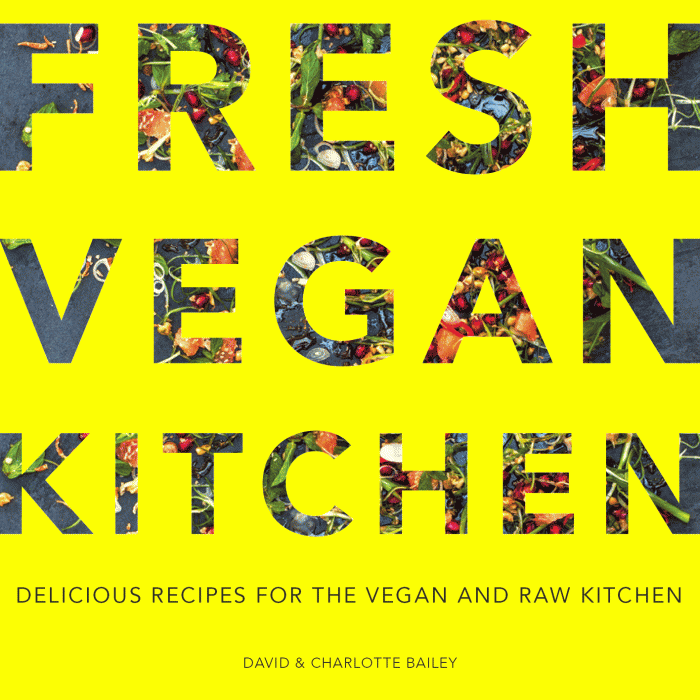
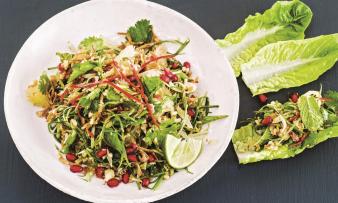
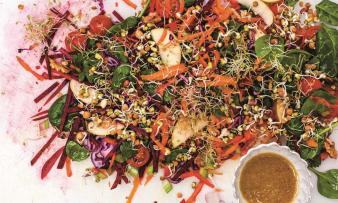
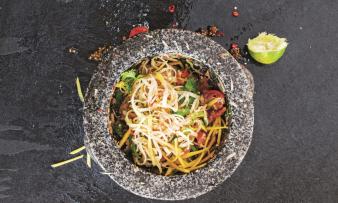
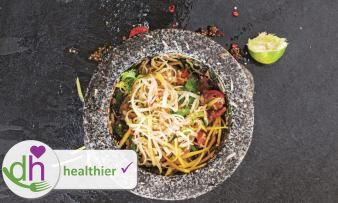
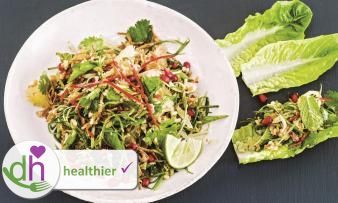
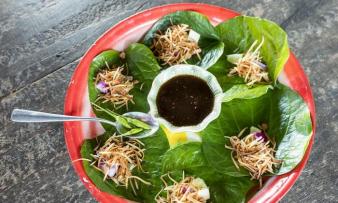
Comments